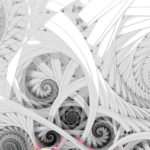- Series:God’s Design, Transcript English
John 1:3
“All things were made by him; and without him was not any thing made that was made.“
 Fractals are incredible, beautiful, and awe-inspiring. Their definition, however, makes them sound mundane. Fractals are abstract objects, and they are defined by non-differentiable functions. As mathematical objects, they are truly beautiful in both the artistic and mathematical definitions of that word.
Fractals are incredible, beautiful, and awe-inspiring. Their definition, however, makes them sound mundane. Fractals are abstract objects, and they are defined by non-differentiable functions. As mathematical objects, they are truly beautiful in both the artistic and mathematical definitions of that word.
Most of us are aware of the math, without being able to replicate or fully understand it. As with most areas of knowledge, a deeper mathematical insight into fractals appears to increase, rather than decrease, people’s fascination with them. But even those of us who have not studied the math find them fascinating.
One famous fractal that I saw involved looking carefully at a pattern, which was like that of a paper doily, based on many triangles. As the image zoomed in on one triangle, it seemed to become more complex until it was exactly the same pattern as the original whole. Concentrating on one corner triangle pattern, as it zoomed in, merely repeated this effect. This is totally unexpected.
Fractals are chaotic in appearance. Indeed, the math has a lot to do with chaos theory. They also frequently resemble objects in nature. It seems that some of the most complex, chaotic networks in nature are actually not random, but can be defined by fractals. Examples of this would be the network of branches produced by a tree, or the double-spiral arms of a galaxy. As is so often the case with other phenomena, fractals remind us that God is a God of order and harmony. Author: Paul F. Taylor
Thank You, Lord, that as we investigate more and more about Your universe, we are truly amazed at how wonderful it is and how great You are. Amen.
Ref: What are fractals? < https://fractalfoundation.org/resources/what-are-fractals/ >, accessed 5/1/2018. Image: Adobe Stock Images, licensed to author.
